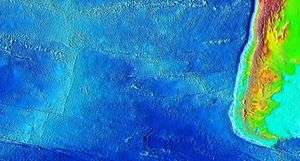Ranquil Formation
| Ranquil Formation Stratigraphic range: Miocene–Pliocene | |
|---|---|
| Type | Geological formation |
| Underlies | Tubul Formation |
| Overlies | Lebu Group |
| Lithology | |
| Primary | Conglomerate with clay and silt matrix, breccia, sandstone, siltstone, mudstone |
| Other | Conglomerate with sand matrix |
| Location | |
| Region | Bío Bío Region |
| Country | Chile |
| Type section | |
| Named for | Caleta Ranquil |
| Named by | Juan Tavera, 1942 |
Ranquil Formation (Spanish: Formación Ranquil) is a Miocene and Pliocene sedimentary formation located in Arauco Province in south–central Chile, including outcrops in Mocha Island. The formation has its greatest thicknesses in the south-west, where its sediments were largely deposited in marine conditions. It overlies unconformably sedimentary formations of the Paleocene-Eocene Lebu Group.[1] The formation is part of the fill of Arauco Basin which is a sedimentary basin that extends south of Concepción.[2]
Macrofossils of the formation are similar to those of Navidad (34° S) and Lacui Formation (43° S) two nearby Miocene marine formations.[3]
The base of Ranquil Formation is the so-called “main unconformity” which is thought to have formed by erosion during a period of tectonic inversion.[4]
The formation was first defined in 1942 by Juan Tavera.[1]
Units
The formation has been subdivided into five units, with the lowermost being made up of sandstone and shale, and the second lowest one being made up of a conglomerate. The middle unit is made up of mudrock and massive sandstone. At some places the middle unit is overlain by a unit made up of sandstone with thin layers of conglomerate and sandstone that has been bioturbated. The uppermost unit include a breccia and the so-called Huenteguapi sandstone.[2] The sediments of Huenteguapi sandstone evidences that a megatsunami struck the coast of south–central Chile in the Pliocene.[2]
Fossil content
Ranquil Formation contains the following trace fossils: Zoophycos, Chondrites, Phycosiphon, Nereites missouriensis, Lockeiasiliquaria, Parataenidium, Ophiomorpha, Rhizocorallium and possibly also Psammichnites.[5]
See also
References
- 1 2 García A., Floreal (1968). Ceccioni, Giovanni, ed. El Terciario de Chile Zona Central (in Spanish). Santiago de Chile: Ediorial Andrés Bello. p. 25–57.
- 1 2 3 Le Roux, J.P.; Nielsen, Sven N.; Kemnitz, Helga; Henriquez, Álvaro (2008). "A Pliocene mega-tsunami deposit and associated features in the Ranquil Formation, southern Chile" (PDF). Sedimentary Geology. 203 (1): 164–180. Retrieved 11 April 2016.
- ↑ Finger, Kenneth L.; Nielsen, Sven N.; Devries, Thomas J.; Encinas, Alfonso; Peterson, Dwan E. (2007). "Paleontologic evidence for sedimentary displacement in Neogene forearc basins of Central Chile" (PDF). Palaios. 22: 3–16. Retrieved 28 July 2016.
- ↑ Becerra, Juan; Contreras-Reyes, Eduardo; Arriagada, César (2013). "Seismic structure and tectonics of the southern Arauco Basin, south-central Chile (~ 38°S)". Tectonophysics. 592: 53–66.
- ↑ Le Reoux, Jacobus P.; Nielsen, Sven N.; Henríquez, Álvaro (2008). "Depositional environment of Stelloglyphus llicoensis isp. nov.: a new radial trace fossil from the Neogene Ranquil Formation, south-central Chile". Revista geológica de Chile. 35 (2): 307–319. Retrieved 29 July 2016.
